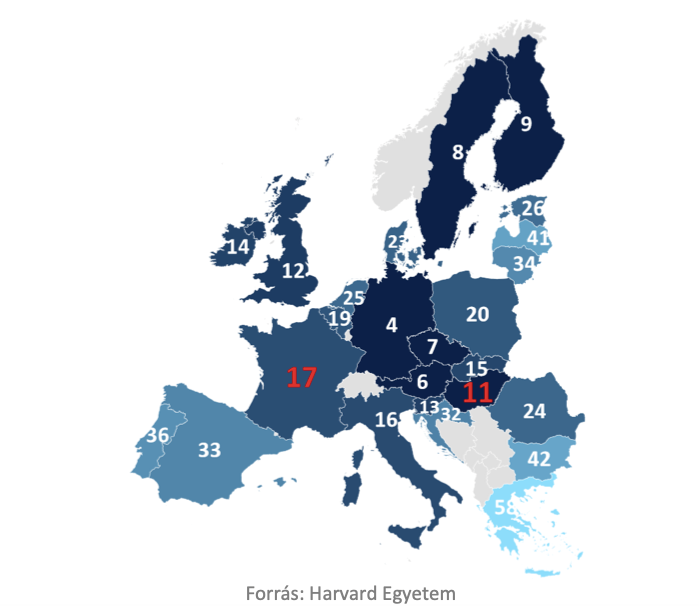Although Hungary’s economic development still lags behind that of France, which outstrips the EU average, the difference declined materially between 2010 and 2017 and the improvement can be perceived in other areas as well.
Hungary’s development level still lags behind that of Western Europe, but the signs of convergence are visible in an increasing number of areas.
At the fourth station of the MNB’s 5+1 series of articles on convergence, we present the degree of Hungary’s convergence relative to France, one of the most developed states of the world.
The examined data show that after 2010 Hungary’s tax regime changed positively by reducing the labour – and capital – tax burden, which strongly supported, in addition to employment and economic growth, fiscal stability. As a result, the Hungarian government debt ratio has set on a persistently declining path, as opposed to the debt ratio of France, which is already close to 100 percent.
Although Hungary’s economic development still lags behind that of France, which outstrips the EU average, the difference declined materially between 2010 and 2017, which improvement can be perceived in other areas as well. Since the French economy is one of the largest and most advanced economies of not only Europe but also of the world, the comparison of Hungary’s macroeconomic and competitive position with that of France may provide a relevant picture on Hungary’s catching-up process.
In 2010, Hungary’s GDP per capita barely exceeded 60 percent of that of France; however, owing to the reform measures taken thereafter, Hungary shows dynamic convergence, in addition to a stable macro-financial balance, and thus in 2017 Hungary’s development level came close to 70 percent of the French value. This suggests that the crisis management and economic stimulus measures taken after 2010 are more successful in Hungary than in France. In the paper below we present Hungary’s convergence in a variety of areas on 5+1 charts.
In recent years, Hungary’s economic growth materially exceeded that of France and it is approximating the French level of development. Between 2010 and 2017, Hungary’s cumulated real GDP growth (17.3 percent) was almost twice as high as growth in France (8.8 percent). In the past years, Hungary – together with other countries of the Visegrád region – became one of the growth drivers of the European Union. By contrast, the economic performance of France lagged behind growth of the EU and the euro area.
The sustainable recovery of the Hungarian economy, which began in 2013, was materially contributed to by the government’s reform measures after 2013 – simultaneously supporting both economic growth and fiscal balance – as well as the monetary policy schemes after 2013. Hungary’s average growth between 2013 and 2017 (3.2 percent) was almost three times as high as that of France (1.2 percent), while cumulated growth in GDP per capita exceeded it by almost five and a half times in this period.
GDP per capita at constant price, purchasing power parity (2010 = 100 percent)
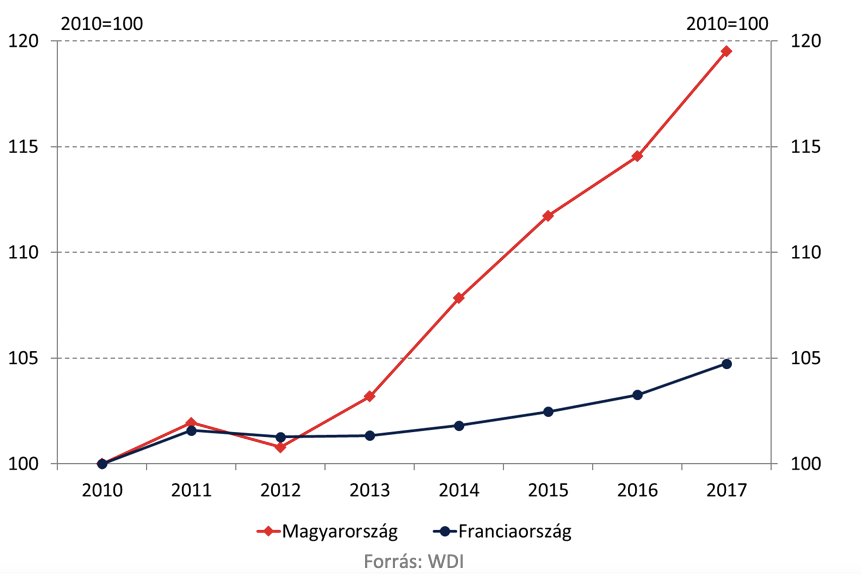
Hungary’s trade surplus as a percent of GDP is substantially more favourable than that of France, considered as an economic great power, which shows a deficit for more than a decade. The positive trade balance, in addition to achieving external balance, is also key to economic growth, and thus it contributes to the attainment of long-term convergence. In the past one and a half decade, Hungary’s trade balance showed a trend increase and in the recent period it was around 8 percent of GDP, while the French index showed an average deficit of 1 percent. This implies an improvement in Hungary’s export competitiveness. Based on the share in world trade, at present France (3.6 percent) is the 6th largest economy, while Hungary (with 0.6 percent) is ranked 37th.
Trade balance as a percent of GDP
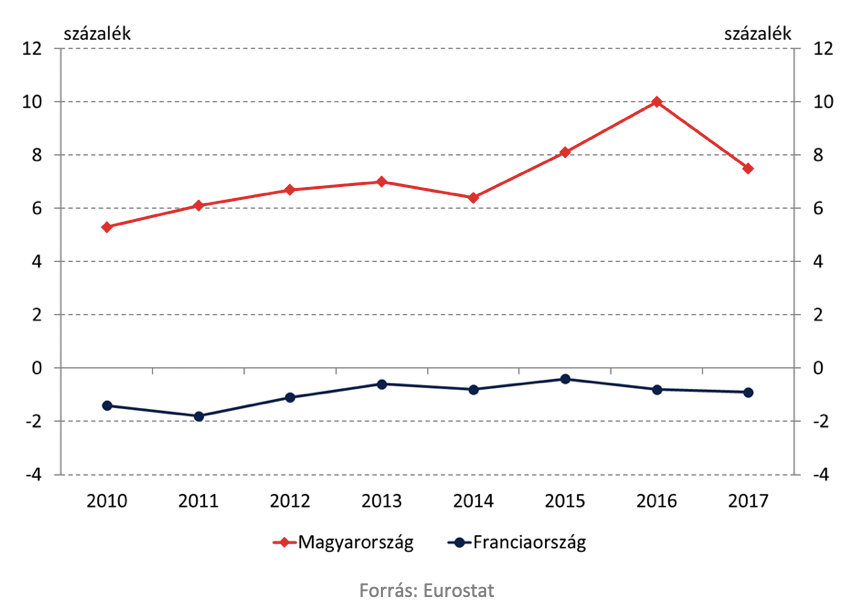
As a result of the measures taken after 2010 to increase employment, the domestic labour market indices showed a major improvement. Since 2010, Hungary achieved the highest rate of employment growth (13.3 percentage points) in the EU, which materially supports economic growth and sustainable convergence. However, Hungary recorded a major improvement not only in the case of the total, national economy indicators, but also among juvenile workers, those approaching the retirement age and the low-qualified workers, attached to the labour market to a smaller degree and usually more vulnerable in terms of the labour market.
The unemployment rate of juvenile workers, which soared during the crisis to 20-25 percent in several European countries, deserves special attention. In Hungary, as a result of the economic activity and the economic policy measures supporting job creation, the unemployment rate of the below 25-year age group fell close to 10 percent, which is far better than the EU average (16.8 percent in 2017). By contrast, the juvenile unemployment rate in France has been steadily around 23 percent since the crisis. Of the more vulnerable labour market groups, employment of low-qualified workers also greatly improved in Hungary, while it decreased in France.
Changes in the unemployment rate of juvenile workers (15-24 years)
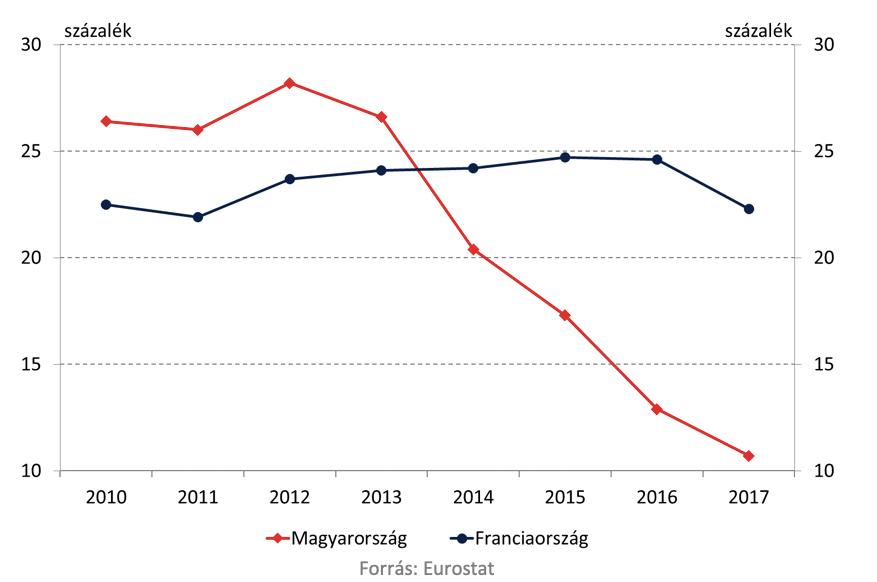
In Hungary, one of the determinant economic measures taken in the post-crisis period was the introduction of the flat rate, proportionate personal income tax scheme, which contributed to growth in employment and to an improvement in the competitiveness of the tax regime.
The primary duty of the government elected in 2010 was to stabilise the fiscal budget and the economy simultaneously, and it regarded the raising of employment as a possible way to achieve this. One of the key instruments to realise these objectives was to shift the focus of tax centralisation from labour taxes to consumption taxes, since prior to 2010, employment was hindered in Hungary by progressive tax burden, which was outstanding by international standards as well.
Recognising this, and setting full employment as a goal, in 2011 a flat rate, proportionate personal income tax was introduced in Hungary, the rate of which initially was 16 percent, and from 2016 it was reduced to 15 percent. By contrast, in the French progressive regime, the highest personal income tax rate was 41 percent during the crisis, which later on – by introducing special tax rates – was raised to 45 percent, and the preferential rate of 5.5 percent was cancelled. In Hungary the flat rate, proportional personal income tax regime supports employment growth both on the extensive and intensive margin, and encourages investment in knowledge, as well as surplus labour.
Changes in the personal income tax rates
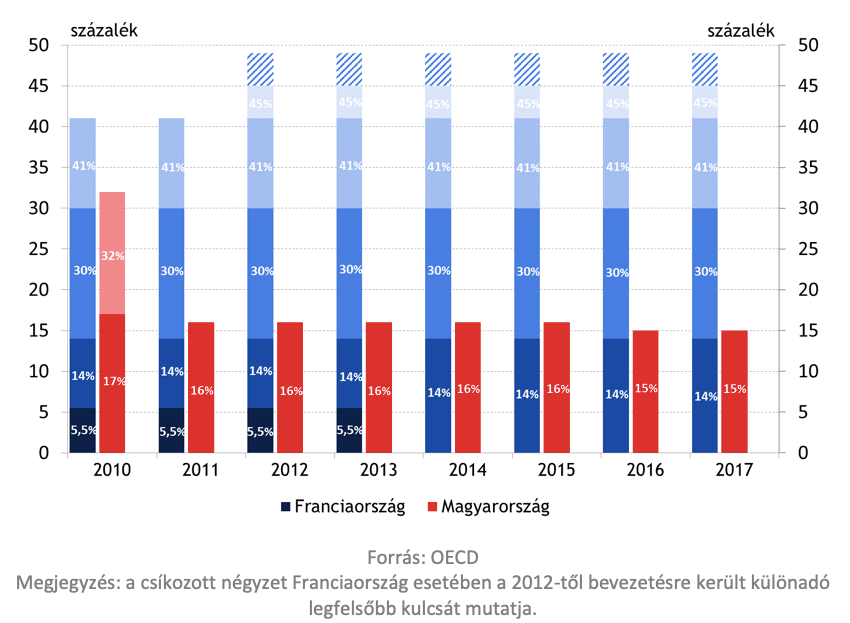
Owing to disciplined fiscal policy and the growth-friendly measures taken after 2010, Hungary has set the debt on a declining path, while the debt ratio of France is close to 100 percent. After 2010, Hungary implemented unconventional measures to stimulate growth in order to reduce the government deficit and enhance economic performance, rather than opting for the classic restrictive policy to manage the crisis. In addition to reducing the labour taxes, fiscal balance was preserved by increasing the sales taxes and introducing solidarity taxes in certain sectors, which later on was also supported by economic growth and the reduction in the shadow economy, as well as declining government interest expenditures. In addition to the latter, the reform of the expenditure side of the fiscal budget (Széll Kálmán plans) and the rationalisation of the formerly unreasonably accommodating social transfers also contributed to the stable fiscal budget and to a decrease in the government debt ratio.
As a result of the persistently moderate deficit and dynamic growth, Hungary’s government debt-to-GDP ratio fell from above 80 percent close to 73 percent between 2010 and 2017. By contrast, after 2013 France registered a persistently rising debt path despite the relatively supportive external environment. Due to the relatively high deficit – exceeding the EU average – and low economic growth, the French debt ratio rose from 85.3 percent to 98.5 percent during the 7 years under review. Not only the size, but also the structure of the Hungarian government debt changed. The improving income position of households made it possible for them to purchase government securities in larger volumes. In parallel with the increasing domestic investor base, the ratio of non-resident holders and foreign currency denomination within the government debt fell to a historic low, which significantly reduced Hungary’s external financial vulnerability.
Gross government debt to GDP ratio
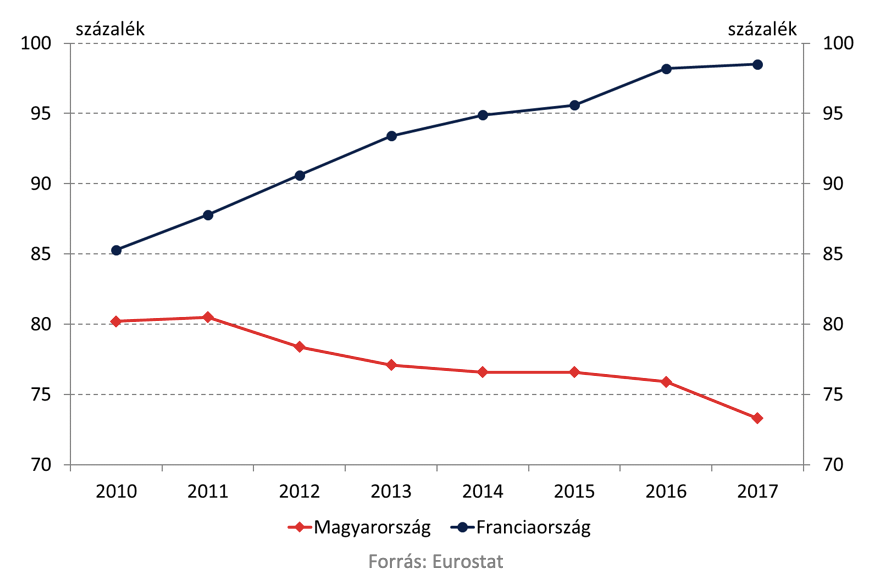
The complexity of the Hungarian economy exceeds that of France.
The Economic Complexity Index (Harvard University) measures the complexity and knowledge intensity of the economy of the individual countries. In the case of the developing and emerging countries, this indicator may also show the probability of the individual countries’ escaping the middle income trap. The calculation of the indicator is based on the diversity of exported goods and the inputs of those, as well as the uniqueness of exported goods. Based on this, Hungary takes the 11th place among the 127 ranked countries, i.e. it is in the first tenth, while France is further back in the ranking, taking the 17th place.
Moreover, France’s position has gradually deteriorated in the past 20 years. In 1999, 2009 and 2016 it was ranked 9th, 13th and 17th, respectively. In the ranking, Hungary is also ahead of several developed western countries, e.g. the United Kingdom, Denmark and the Netherlands, in addition to France. Economic complexity is suitable for estimating long-term economic growth, which is also quantified by countries. In the case of Hungary, the research team of Harvard University projects an average annual potential growth of 4.1 percent until 2026, while in the case of France only 3.5 percent.
Economic Complexity Rankings (from 127 countries)
